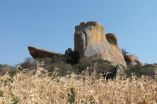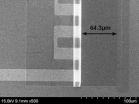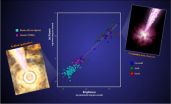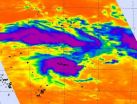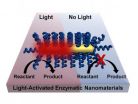(Press-News.org) New research by a University of Alberta archeologist may lead to a rethinking of how, when and from where our ancestors left Africa.
U of A researcher and anthropology chair Pamela Willoughby's explorations in the Iringa region of southern Tanzania yielded fossils and other evidence that records the beginnings of our own species, Homo sapiens. Her research, recently published in the journal Quaternary International, may be key to answering questions about early human occupation and the migration out of Africa about 60,000 to 50,000 years ago, which led to modern humans colonizing the globe.
From two sites, Mlambalasi and nearby Magubike, she and members of her team, the Iringa Region Archaeological Project, uncovered artifacts that outline continuous human occupation between modern times and at least 200,000 years ago, including during a late Ice Age period when a near extinction-level event, or "genetic bottleneck," likely occurred.
Now, Willoughby and her team are working with people in the region to develop this area for ecotourism, to assist the region economically and create incentives to protect its archeological history.
"Some of these sites have signs that people were using them starting around 300,000 years ago. In fact, they're still being used today," she said. "But the idea that you have such ancient human occupation preserved in some of these places is pretty remarkable."
Magubike: Home to a modern Stone Age family?
Willoughby says one of the fascinating things about Magubike is the presence of a large rock shelter with an intact overhanging roof. The excavations yielded unprecedented ancient artifacts and fossils from under this roof. Samples from the site date from the earliest stages of the middle Stone Age to the Iron Age. The earlier deposits include human teeth and artifacts such as animal bones, shells and thousands of flaked stone tools.
The Iron Age finds can be dated using radiocarbon, but the older deposits must go through more specialized processes, such as electron spin resonance, to determine their age. Other parts of the Magubike rock shelter, excavated in 2006 and 2008, include occupations from after the middle Stone Age. Taken together, this information could be crucial to tracking the evolutionary development of the inhabitants.
"What's important about the whole sequence is that we may have a continuous record of human occupation," said Willoughby. "If we do—and we can prove it through these special dating techniques—then we have a place people lived in over the bottleneck."
Rugged, hilly terrain may have been key to survival
The team made similar findings at Mlambalasi, about 20 kilometres from Magubike. Among the findings at this site was a fragmentary human skeleton that probably dates to the late Pleistocene Ice Age—after the out-of-Africa expansion but at the end of the bottleneck period. The bottleneck theory explains what geneticists have found by studying the mitochondrial DNA of living people—that all non-Africans are descended from one lineage of people who left Africa about 50,000 years ago.
Reconstructions of past environments through pollen and other archeological records in Iringa suggest that people abandoned the lowland, tropical and coastal areas during that period but remained in the highlands, where vegetation has remained mostly unchanged over the last 50,000 years. Those who moved to higher ground may have found what is likely one of the few places that facilitated their survival and forced their adaptation. Further testing will determine whether these findings point to a clearer link to our African ancestors—a find Willoughby says could put that region of Tanzania on many archeologists' radar.
"It was only about 20 years ago that people recognized that modern Homo sapiens actually had an African ancestry, and everyone was focused on looking at early Homo sapiens in Europe who appeared around 40,000 years ago," she said. "But we now know that as far as back as around 200,000 years ago, Africa was inhabited by people who were already physically exactly like us today or really close to being the same as us. All of a sudden, it's not Europe in this time period that's really important, it's Africa."
Engaging community yields co-operation, opportunity
Along with its scientific significance, Willoughby's work may be a linchpin to potential economic growth for the region. Since 2005, when a local cultural officer showed her the sites, she has been sharing information about her research with local citizens, schools and government—opening up opportunities for more research and co-operation. She keeps the region informed of the team's findings through posters distributed around Iringa, and has asked for and accepted assistance from local scholars. Now the community is also looking for her help in establishing the historic sites as a tourist attraction that will benefit the region.
Willoughby says she feels fortunate to have the support of the Tanzanian people. She tells people it is a shared history she is uncovering, something she is honoured to be able to do.
"They're telling me, 'You're putting Iringa on the map,'" she said. "As long as they keep letting me work there, and keep letting the people working with me work there, we'll be happy."
INFORMATION:
Tracing humanity's African ancestry may mean rewriting 'out of Africa' dates
UAlberta archeologist's new research may lead to rethinking how and when our ancestors left Africa to colonize the globe
2012-12-14
ELSE PRESS RELEASES FROM THIS DATE:
Better tools for saving water and keeping peaches healthy
2012-12-14
Peach growers in California may soon have better tools for saving water because of work by U.S. Department of Agriculture (USDA) scientists in Parlier, Calif.
Agricultural Research Service (ARS) scientist Dong Wang is evaluating whether infrared sensors and thermal technology can help peach growers decide precisely when to irrigate in California's San Joaquin Valley. ARS is USDA's principal intramural scientific research agency, and the research supports the USDA priority of promoting international food security.
Irrigation is the primary source of water for agriculture ...
Dark Ages scourge enlightens modern struggle between man and microbes
2012-12-14
The plague-causing bacteria Yersinia pestis evades detection and establishes a stronghold without setting off the body's early alarms.
New discoveries reported this week help explain how the stealthy agent of Black Death avoids tripping a self-destruct mechanism inside germ-destroying cells.
The authors of the study, appearing in the Dec. 13 issue of Cell Host & Microbe, are Dr. Christopher N. LaRock of the University of Washington Department of Microbiology and Dr. Brad Cookson, UW professor of microbiology and laboratory medicine.
Normally, certain defender cells ...
3 new species of venomous primate identified by MU researcher
2012-12-14
A venomous primate with two tongues would seem safe from the pet trade, but the big-eyed, teddy-bear face of the slow loris (Nycticebus sp.) has made them a target for illegal pet poachers throughout the animal's range in southeastern Asia and nearby islands. A University of Missouri doctoral student and her colleagues recently identified three new species of slow loris. The primates had originally been grouped with another species. Dividing the species into four distinct classes means the risk of extinction is greater than previously believed for the animals but could ...
Engineers roll up their sleeves -- and then do same with inductors
2012-12-14
CHAMPAIGN, Ill. — On the road to smaller, high-performance electronics, University of Illinois researchers have smoothed one speed bump by shrinking a key, yet notoriously large element of integrated circuits.
Three-dimensional rolled-up inductors have a footprint more than 100 times smaller without sacrificing performance. The researchers published their new design paradigm in the journal Nano Letters.
"It's a new concept for old technology," said team leader Xiuling Li, a professor of electrical and computer engineering at the University of Illinois.
Inductors, ...
Study reveals a remarkable symmetry in black hole jets
2012-12-14
Black holes range from modest objects formed when individual stars end their lives to behemoths billions of times more massive that rule the centers of galaxies. A new study using data from NASA's Swift satellite and Fermi Gamma-ray Space Telescope shows that high-speed jets launched from active black holes possess fundamental similarities regardless of mass, age or environment. The result provides a tantalizing hint that common physical processes are at work.
"What we're seeing is that once any black hole produces a jet, the same fixed fraction of energy generates the ...
NASA sees intensifying tropical cyclone moving over Samoan Islands
2012-12-14
VIDEO:
NASA's TRMM satellite passed above an intensifying Tropical Cyclone Evan on Dec. 11 at 1759 UTC (12:59 p.m. EST/U.S.) and saw the tallest thunderstorms around Evan's center of circulation reached...
Click here for more information.
NASA satellites have been monitoring Tropical Cyclone Evan and providing data to forecasters who expected the storm to intensify. On Dec. 13, Evan had grown from a tropical storm into a cyclone as NASA satellites observed cloud formation, ...
Rice uses light to remotely trigger biochemical reactions
2012-12-14
HOUSTON – (Dec. 13, 2012) – Since Edison's first bulb, heat has been a mostly undesirable byproduct of light. Now researchers at Rice University are turning light into heat at the point of need, on the nanoscale, to trigger biochemical reactions remotely on demand.
The method created by the Rice labs of Michael Wong, Ramon Gonzalez and Naomi Halas and reported today in the American Chemical Society journal ACS Nano makes use of materials derived from unique microbes – thermophiles – that thrive at high temperatures but shut down at room temperature.
The Rice project ...
Team solves mystery associated with DNA repair
2012-12-14
CHAMPAIGN, lll. — Every time a human or bacterial cell divides it first must copy its DNA. Specialized proteins unzip the intertwined DNA strands while others follow and build new strands, using the originals as templates. Whenever these proteins encounter a break – and there are many – they stop and retreat, allowing a new cast of molecular players to enter the scene.
Scientists have long sought to understand how one of these players, a repair protein known as RecA in bacterial cells, helps broken DNA find a way to bridge the gap. They knew that RecA guided a broken ...
More signs of the benefits of marriage?
2012-12-14
TORONTO, Dec. 13, 2012—There's new evidence about the benefits of marriage.
Women who are married suffer less partner abuse, substance abuse or post-partum depression around the time of pregnancy than women who are cohabitating or do not have a partner, a new study has found.
Unmarried women who lived with their partners for less than two years were more likely to experience at least one of the three problems. However, these problems became less frequent the longer the couple lived together.
The problems were most common among women who were separated or divorced, especially ...
Top officials meet at ONR as Arctic changes quicken
2012-12-14
ARLINGTON, Va.—The Navy's chief of naval research, Rear Adm. Matthew Klunder, met this week with leaders from U.S. and Canadian government agencies to address research efforts in the Arctic, in response to dramatic and accelerating changes in summer sea ice coverage.
"Our Sailors and Marines need to have a full understanding of the dynamic Arctic environment, which will be critical to protecting and maintaining our national, economic and security interests," said Klunder. "Our research will allow us to know what's happening, to predict what is likely to come for the region, ...
LAST 30 PRESS RELEASES:
Structure of dopamine-releasing neurons relates to the type of circuits they form for smell-processing
Reducing social isolation protects the brain in later life
Keeping the heart healthy increases longevity even after cancer
Young adults commonly mix cannabis with nicotine and tobacco
Comprehensive review illuminates tau protein's dual nature in brain health, disease, and emerging psychiatric connections
Book prepares K-12 leaders for the next public health crisis
Storms in the Southern Ocean mitigates global warming
Seals on the move: Research reveals key data for offshore development and international ecology
Sports injuries sustained during your period might be more severe
World's first successful 2 Tbit/s free-space optical communication using small optical terminals mountable on satellites and HAPS
Can intimate relationships affect your heart? New study says ‘yes’
Scalable and healable gradient textiles for multi‑scenario radiative cooling via bicomponent blow spinning
Research shows informed traders never let a good climate crisis go to waste
Intelligent XGBoost framework enhances asphalt pavement skid resistance assessment
Dual-function biomaterials for postoperative osteosarcoma: Tumor suppression and bone regeneration
New framework reveals where transport emissions concentrate in Singapore
NTP-enhanced lattice oxygen activation in Ce-Co catalysts for low-temperature soot combustion
Synergistic interface engineering in Cu-Zn-Ce catalysts for efficient CO2 hydrogenation to methanol
COVID-19 leaves a lasting mark on the human brain
Scientists use ultrasound to soften and treat cancer tumors without damaging healthy tissue
Community swimming program for Black youth boosts skills, sense of belonging, study finds
Specific depressive symptoms in midlife linked to increased dementia risk
An ‘illuminating’ design sheds light on cholesterol
Who is more likely to get long COVID?
Study showcases resilience and rapid growth of “living rocks”
Naval Research Lab diver earns Office of Naval Research 2025 Sailor of the Year
New Mayo-led study establishes practical definition for rapidly progressive dementia
Fossil fuel industry’s “climate false solutions” reinforce its power and aggravate environmental injustice
Researchers reveal bias in a widely used measure of algorithm performance
Alcohol causes cancer. A study from IOCB Prague confirms damage to DNA and shows how cells defend against it
[Press-News.org] Tracing humanity's African ancestry may mean rewriting 'out of Africa' datesUAlberta archeologist's new research may lead to rethinking how and when our ancestors left Africa to colonize the globe
